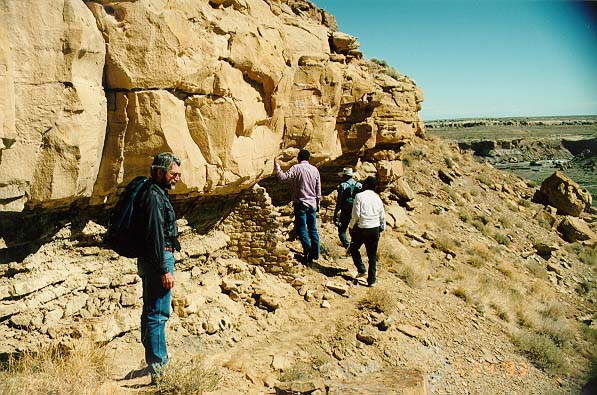

The ledge along the front of the ruins varied in width from sort of wide to quite narrow. At any given point you could find yourself being only inches away from a 350 foot drop to the canyon floor. In SOME places, but not all, the ledge of the ground surface had a minor-to-worse slope tilted toward the edge which made walking difficult. Along the whole length a great deal of that ground-surface was covered by loose rocks, either weathered from the cliffs above or intermixed with fallen stones from the ancient structures. The wind was dangerous and unpredictable with strong gusts one moment and utter still next. The only way it seemed safe being there was by staying inside one of the ruins. On the ledge the only way to be safe seemed to be to crawl on all fours along the cliff wall or to lay down and crawl --- and even then I wasn't sure.
The graphic at the top of the page is one of the best available at this time illustrating the ledge-like features along with the rock strewn slope of the ground-surface as it reaches toward the cliff-edge drop off. The following paragraph describing the Astronomer's Rooms is from the report cited further down by Richard Stoffle, et al:
On the predominant ledge just below the Sun Dagger there are a series of rooms that extends around most of Fajada Butte. These rooms have not been excavated but erosion has uncovered most of them, revealing their general outline. Pottery shards are present near all rooms visited. One room is circular in shape, suggesting to both archaeologists and to some Pueblo elders that it was a kiva. It is estimated that 20-30 rooms were built at this level. The Indian people said that the rooms were where the Indian astronomers lived. The term astronomers is being used to indicate that, according to the some elders, full -time specialist time keepers may have used the various solar calendars on Fajada Butte. Fajada Butte was also perceived as a place where astronomers from other Chaco communities would come and visit. These visits would be a part of critical events, such as those marked by the Sun Dagger, but they would also involve continuous interactions, ceremonies, talking, and learning about astronomy. More than one elder viewed the rooms and solar calendars as part of a school for teaching about astronomy.
The graphic of the Astronomers' Rooms and text were produced as part of an ethnographic assessment of the cultural ties of American Indians to Fajada Butte, which is located in Chaco Culture National Historical Park in New Mexico. The study was funded by the National Park Service on September 15, 1992, and was managed by the New Mexico State Historic Preservation Office.
The findings of the study are available in the report entitled American Indians and Fajada Butte (1994) by Richard Stoffle, Michael Evans, Nieves Zedeno, Brent Stoffle and Cindy Kesel. Tucson, Arizona: Bureau of Applied Research in Anthropology, University of Arizona. The complete report in PDF, including a section on the astronomer's rooms as found on page 41, can be reached by clicking HERE.
RETURN TO:
SEE:
YAMIL LU'UM
HIGH MOUNTAIN ZENDO
MAYAN RUINS AND THE SPRING EQUINOX
SO, DID THE WANDERLING FLY?
(click image)
SEE ALSO:
MEDITATION ALONG METEOR CRATER RIM
AS WELL AS:
THE METEOR CRATER METEORITE: WHAT HAPPENED TO IT?
ON THE CRATER FLOOR: Meteor Crater, Arizona